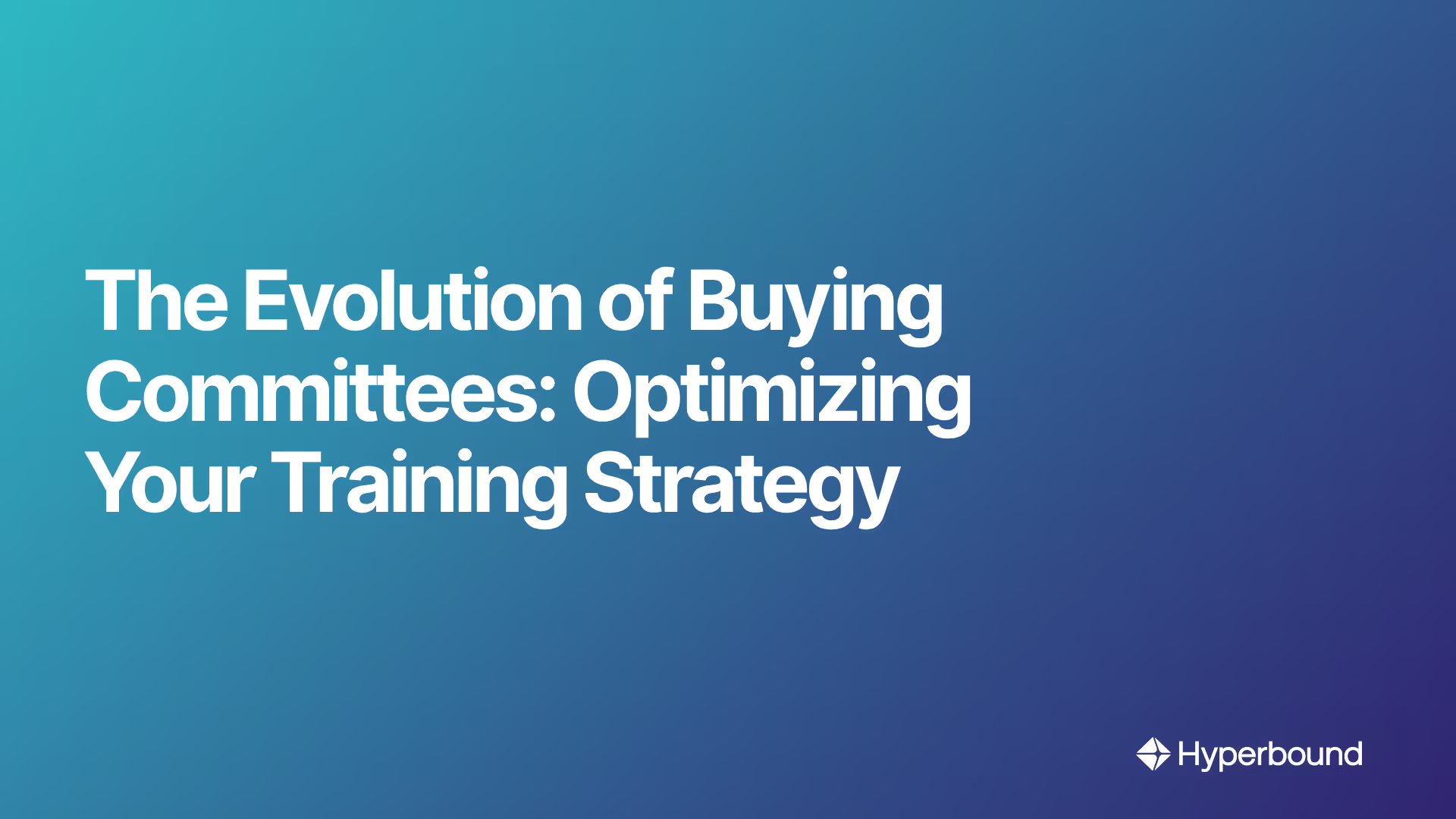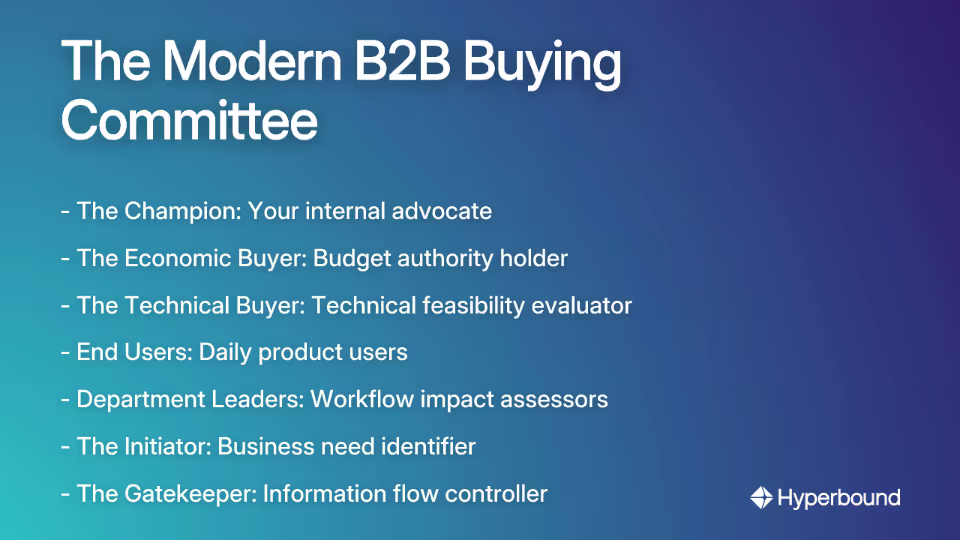
You've spent weeks chasing the elusive "decision-maker." Your sales team has sent countless emails to C-suite executives, hoping for that one reply that will open the door to a deal. But the silence is deafening. Sound familiar?
If you're still training your sales teams to hunt for the mythical single decision-maker who can say "yes" with a stroke of a pen, you're setting them up for failure in today's B2B landscape.
"99% of SDRs and marketers are doing precisely the opposite. They outreach only decision-makers hoping the timing is right, and there is a chance to book a call. In most cases, they never get even a polite 'no' as a reply," notes one sales professional.
The reality? The B2B buying landscape has fundamentally transformed. Success today depends not on finding one person, but on building consensus across a growing committee of stakeholders. This article outlines the training strategy your team needs to adapt and win in this new reality.
The Evolution of the Buying Committee: From a Handful to a Crowd
Time for a history lesson. Not long ago, B2B purchasing decisions were relatively straightforward. A department head identified a need, secured budget approval from finance, and made a purchase. The entire process might involve just 2-3 people.
Today? The average software buying committee consists of 6 to 10 members across different departments and levels of seniority. In mid-size or enterprise companies (100-500 employees), the number of people influencing a purchase can be around 7.
Several factors have driven this expansion:

- Increased Solution Complexity: Modern B2B solutions affect workflows across entire organizations, requiring input from diverse stakeholders to ensure compatibility and adoption.
- Strategic Business Impact: Software purchases are no longer just operational decisions but strategic ones that can transform entire business models.
- Risk Mitigation: With significant investments at stake, organizations involve more stakeholders to ensure thorough vetting and reduce the risk of failed implementations.
- Governance Requirements: Stricter regulations and compliance standards have made cross-functional approval a necessity for many purchases.
The days of the sole decision-maker are over. Your sales training needs to reflect this new reality.
Decoding the Modern Buying Committee: A Roster of Key Roles
Before we dive into training strategies, let's clarify who makes up today's buying committee. Many sales professionals express confusion about stakeholder identification: "Are they PMs? Anyone I collaborate with... The end user? I'm confused," as one professional puts it.
Here's a comprehensive breakdown of the key players:

- The Champion: Your internal advocate who believes in your solution and works to build support. They're your most valuable ally.
- The Economic Buyer: Typically a C-level executive with budget authority who focuses on ROI and strategic alignment.
- The Technical Buyer: Often from IT or engineering, they evaluate technical feasibility, security, integration capabilities, and compliance.
- End Users: The people who will use your product daily. While they may lack purchasing authority, their adoption is critical for success.
- Department Leaders: Heads of affected departments who assess the solution's impact on their teams and workflows.
- The Initiator: The person who first identifies a business need and begins the search for a solution.
- The Gatekeeper: Controls information flow and access to other committee members (could be an executive assistant or procurement manager).
Your New Training Playbook: Strategies for Engaging the Entire Committee
Now that we understand the complex landscape of modern buying committees, let's explore four essential training principles to help your sales team navigate it successfully.
Principle 1: Stakeholder Mapping & Analysis - Know Your Battlefield
Train your team to go beyond simply identifying stakeholders. They need to analyze them methodically.
Actionable Training Tips:
- Implement structured stakeholder mapping exercises that identify not just titles, but spheres of influence, priorities, and potential objections
- Teach sales reps to conduct a comprehensive Stakeholder Impact Analysis that considers five dimensions for each role: outcomes they care about, how they're affected, the scale of impact, your contribution to their success, and potential risks
- Create ideal stakeholder profiles based on customer interviews: "Run in-depth interviews with your customers and ask who (job role) is usually taking part in consideration... but are not the decision-makers. Make a list of these job roles," suggests one sales leader
Principle 2: Multithreading & Relationship Building - Go Wide, Not Just High
Abandon the single-threaded approach that focuses exclusively on executives. Multithreading—engaging multiple stakeholders simultaneously—is essential for building broad support.
Actionable Training Tips:
- Role-play scenarios where sales reps must maintain multiple parallel conversations with different stakeholders
- Teach relationship-building techniques specific to each stakeholder type
- Train on identifying and cultivating champions at various organizational levels
- Address the common complaint that "Mid-managers don't like vendors who are jumping over their heads" by teaching proper protocols for expanding connections within an organization
Many sales professionals have discovered that "once you engage with the lower-grade employees who are not decision-makers but might be interested in your product, [you] generate much more quality opportunities." This insight should be central to your training approach.

Principle 3: Targeted Content & Personalized Communication - Speak Their Language
Each stakeholder has different priorities, speaks different jargon, and needs different information to make decisions. Your team needs to communicate accordingly.
Actionable Training Tips:
- Develop stakeholder-specific content templates that address the unique concerns of each role
- For Economic Buyers: Train on creating and presenting ROI models and business cases
- For Technical Buyers: Equip sales reps with technical documentation, security frameworks, and integration capabilities
- For End Users: Focus on practical benefits, usability, and day-to-day improvements
- For Champions: Provide internal "sales decks" they can use to advocate on your behalf
Principle 4: Master the All-Hands Discovery Call - Structuring for Success
Many sales professionals struggle with discovery calls involving multiple stakeholders. As one rep with nearly a decade of experience admits: "I've worked in this industry for almost 10 years and never had this scenario this early and I'm struggling with how to structure the call."
Actionable Training Template:
- Open with Strategic Context: Train reps to acknowledge the significance of having multiple executives present with language like: "Often when I have numerous executives on a call, it tells me the topic may align with a high-level strategic priority. Could we perhaps start there?"
- Executive-First Questioning: Address questions to the CEO and CFO first, as "they want to ask their questions first and usually don't stick around for the whole call."
- Bridge to User Experience: Teach reps how to transition from high-level strategic discussions to practical implementation concerns that matter to end users and department heads.
- Close with Clear Next Steps: End every multi-stakeholder call with specific commitments and a framework for who will be involved in subsequent discussions.
Mastering this multi-stakeholder call structure takes practice. Reps need a safe environment to try these techniques, refine their language, and learn to pivot based on different stakeholder responses. AI sales roleplay platforms like Hyperbound allow reps to practice these exact scenarios against dynamic AI buyer personas, ensuring they are prepared for the real thing.
Leveraging Tools and Frameworks for the Modern Era
To support your newly trained sales team, introduce methodologies and technologies specifically designed for complex, multi-stakeholder sales processes.
Sales Methodologies Worth Implementing:
- The Miller Heiman Strategic Selling Approach: This methodology specifically teaches sales professionals how to segment decision-makers into groups such as Economic, Technical, and User Buyers, plus Champions, allowing for tailored engagement strategies.
- MEDDPICC: This qualification framework helps sales teams rigorously evaluate enterprise deals by identifying Metrics, Economic Buyers, Decision Criteria, Decision Process, Paper Process, Identify Pain, Champion, and Competition.
Enabling Technology:
- Digital Sales Rooms: Platforms that create a centralized, shared space where all committee members can access relevant materials, track progress, and collaborate.
- Stakeholder Management Platforms: Tools that help centralize stakeholder data, automate personalized communication, and track engagement across the buying committee.
- AI Sales Coaching Platforms: Tools like Hyperbound provide a crucial practice layer. They use AI to create realistic roleplay scenarios, score real calls against your methodology (like MEDDPICC), and provide instant feedback, ensuring your team can actually execute these complex strategies effectively.
From Chasing to Orchestrating: A New Mindset for Sales Success
The fundamental shift in B2B buying demands a corresponding shift in how we train our sales teams. The goal is no longer to chase a single, elusive decision-maker. Instead, sales professionals must become orchestrators, skillfully building consensus across diverse and influential stakeholders.
This shift requires more than new tactics—it requires a new mindset. Your training programs should emphasize:
- Relationship-building over transaction-seeking
- Value facilitation over product pushing
- Consensus-building over convincing
- Strategic patience over rushed closings
When sales teams understand the complexity of modern buying committees and are equipped with the strategies to navigate them effectively, they transform from frustrated cold-callers into trusted advisors capable of orchestrating complex deals.
Key Takeaways for Your Sales Training Strategy
- Recognize Reality: The solo decision-maker is a myth. Train your team for the reality of 6-10 person buying committees.
- Map the Terrain: Teach systematic stakeholder mapping and analysis.
- Go Wide: Implement multithreading strategies to engage stakeholders across the organization.
- Speak Their Language: Develop role-specific communication approaches and content.
- Orchestrate Conversations: Master the art of all-hands discovery calls with multiple stakeholders.
- Leverage Methodology: Implement frameworks specifically designed for complex B2B sales.
- Enable with Technology: Use AI coaching platforms to let your team practice and master these new skills in a scalable, risk-free environment.
The evolution of buying committees from small groups to diverse teams represents both a challenge and an opportunity. Those who adapt their training strategies to this new reality will gain a significant competitive advantage, while those who cling to outdated approaches will find themselves increasingly frustrated by low response rates and stalled deals.
Stop training your team to hunt for kings. Start training them to build coalitions. It's time to update your sales playbook for the way decisions are actually made today.
Frequently Asked Questions
What is a B2B buying committee?
A B2B buying committee is a group of individuals from different departments within an organization who collectively influence and make purchasing decisions. Unlike the traditional model of a single decision-maker, today's committees include diverse roles such as technical evaluators, end-users, department heads, and financial stakeholders. The goal of the committee is to ensure a new solution aligns with the company's strategic goals, technical requirements, and budget while mitigating risks.
Why has the single decision-maker been replaced by a buying committee?
The single decision-maker has been replaced by a buying committee primarily due to the increasing complexity, cost, and strategic impact of modern B2B solutions. Companies form committees to mitigate risks associated with large investments. With solutions affecting multiple departments, input is needed from various stakeholders to ensure compatibility, user adoption, and compliance with governance requirements. This collaborative approach ensures a more thoroughly vetted purchasing decision.
Who are the most common roles on a buying committee?
The most common roles on a buying committee include the Champion, the Economic Buyer, the Technical Buyer, End Users, and Department Leaders. Each role has a unique focus: the Champion advocates for your solution internally; the Economic Buyer controls the budget; the Technical Buyer assesses feasibility and integration; End Users are concerned with daily usability; and Department Leaders evaluate the impact on their team's workflows. Identifying and engaging each of these players is crucial.
What is multithreading in sales?
Multithreading in sales is the practice of building relationships with multiple stakeholders within a target account simultaneously, rather than focusing on a single point of contact. This strategy is essential for navigating modern buying committees. By engaging with different members—from end-users to C-level executives—you build broader support, gather diverse insights, and protect your deal from stalling if your primary contact leaves the company or loses influence.
How can I effectively engage different members of the buying committee?
To effectively engage different members of the buying committee, you must personalize your communication and content to address each stakeholder's specific priorities and concerns. This means speaking the language of each role. For an Economic Buyer, focus on ROI and business cases. For a Technical Buyer, provide security documentation and integration details. For End Users, highlight day-to-day benefits and ease of use. A one-size-fits-all approach will fail to resonate with the diverse needs of the committee.
What is the biggest mistake sales reps make when selling to a buying committee?
The biggest mistake sales reps make is continuing to focus all their efforts on finding and convincing a single, high-level decision-maker while ignoring the other influential members of the committee. This outdated, single-threaded approach leads to stalled deals because it fails to build the necessary consensus for a purchase. Successful modern selling requires an orchestration mindset, where the salesperson works to align the entire committee by addressing their collective needs and building widespread support for the solution.

Book a demo with Hyperbound
.png)













